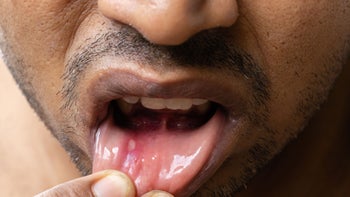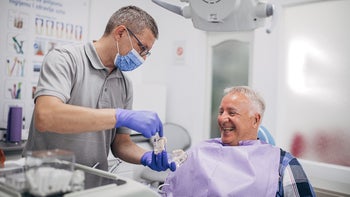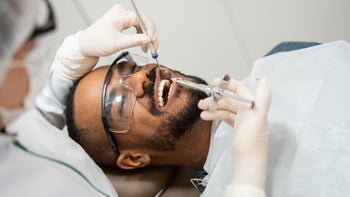
Tooth Infection: Symptoms, Causes, Treatment and More
Key takeaways:
A tooth infection can start without symptoms, so good dental hygiene is important.
Tooth infections and abscesses are usually treated with antibiotics and dental procedures.
It’s important to treat any dental infection before it spreads or leads to complications.
Table of contents
Everyone has germs in their mouths. Bacteria cover the teeth, tongue, and every other surface of the mouth. But a healthy mouth has natural protection against infection. With good dental care, you’ll keep bad bacteria away and keep the risk of tooth infections at bay. When cracks appear in that armor — through cavities, gum disease, or dental trauma — bacteria can find their way in and start to cause trouble.
Tooth infections are painful and can result in teeth needing to be pulled. Worse, they can cause very real health complications that extend far beyond the mouth. Dental infections can affect the tooth itself and the nearby gums. These pockets of infection are called abscesses.
Let’s take a closer look at what to do if you think you have an infected tooth, and which treatments can get you fast relief.
Search and compare options
Tooth infection symptoms
Pain is one of the most common signs of a tooth infection. Other signs of a tooth infection include:
Tooth sensitivity to hot or cold temperature foods
Tooth sensitivity to pressure
Redness or tenderness of the gums
Swelling of the mouth, jaw, or face
Bad taste in the mouth
Bad breath, even after brushing and rinsing
Difficulty chewing
Fever
Symptoms of a tooth infection can start small. But without treatment it can spread and become a bigger problem. Because teeth are connected to so many nerves, pain from an infected tooth can also extend into the jaw, face, and neck.
When tooth pain becomes an emergency: Find out when you should head to the emergency room for dental pain.
Paying for dental care: Follow these tips for finding free or low-cost dental care in your area.
Need to have your wisdom teeth removed? Three people share their experiences to help you know what to expect with wisdom tooth extraction.
Tooth infection causes
Tooth infections and abscesses are usually caused by bacteria getting into the tooth and surrounding tissues. This can happen if there’s damage to the natural protective defenses in the mouth. Tooth infections in particular, tend to surface as a result of:
Gum damage (periodontal disease)
Cracked tooth
Cavities and gum damage are both caused by poor oral hygiene and the buildup of dental plaque on and around the teeth.
Wisdom teeth starting to come in is another, but less common, cause of dental infections. When wisdom teeth grow, they’re typically only partially in the mouth. This leaves a flap of gum tissue that can trap food and bacteria and lead to a wisdom tooth infection. This is called pericoronitis and can be treated by your dental care provider.
Tooth infection treatment
Treatment for a tooth infection or abscess will depend on your symptoms and how far the infection has progressed. Some treatment options include:
Antibiotics: Antibiotic medications are commonly used to treat tooth infections and can provide temporary pain relief. Treatment may take a few weeks, or even months, depending on the severity of the infection.
Incision and drainage: In some cases, you may need surgery to drain an abscess and remove dead tissue.
Cavity filling: A hole in the tooth enamel caused by decay can be repaired by filling it. To do this, your dentist will drill out the damaged area and add a new filling.
Removal of the tooth pulp: Inflammation of the tooth pulp can be treated by removing the pulp from the upper part of the tooth.
Root canal: If there’s severe decay, the complete root and pulp will need to be removed.
Extraction: In some cases, if there’s too much damage to the tooth for it to be saved, your dentist will remove the tooth.
Best antibiotics for tooth infections
You’ll likely take antibiotics for 7 to 10 days to decrease the amount of infection around the tooth. Dentists usually have a few different antibiotics options that they prescribe for tooth infections and abscesses.
Penicillin antibiotics
Penicillin antibiotics include:
Amoxicillin is usually the first choice for a tooth infection treatment. If your tooth infection is more serious, your dentist may prescribe a combination of amoxicillin and clavulanate (Augmentin). This combination is stronger and more effective against tooth infections.
Clindamycin
In some cases, the bacteria causing your tooth infection can be resistant to amoxicillin. If so, your dentist may prescribe clindamycin for your tooth infection. Or, if you have a penicillin allergy, you might be prescribed this medication instead.
Metronidazole
Metronidazole, when combined with amoxicillin, is very useful for treating a tooth infection. The downside is how it interacts with some common things, including:
Alcohol
Blood thinners
Anti-seizure medications
Medications used to treat alcoholism
Let your prescriber know about all medications you are taking. And you’ll want to avoid all alcohol or alcohol-containing products (like mouthwash, for example) while taking metronidazole. Consuming alcohol with metronidazole can make you seriously ill.
Are there any over-the-counter antibiotics for tooth infections?
Antibiotics for tooth infections require a prescription from a healthcare professional.
Due to the growing problem of antibiotic resistance, the FDA cautions against using leftover antibiotics from a previous illness or medicines prescribed for someone else.
Home remedies for tooth infection
There are ways to relieve the pain and swelling from a tooth infection at home. Steps you might try on your own include:
Rinsing your mouth with warm salt water
Applying baking soda paste to the tooth
Rinsing with diluted hydrogen peroxide
Using cold compresses
Taking over-the-counter (OTC) pain relief medicines, such as nonsteroidal anti-inflammatory drugs (NSAIDs)
Using herbal treatments such as clove oil, vanilla extract, peppermint, or garlic paste on the tooth
Remember, if you experience tooth infection symptoms, it’s important to see a dentist as soon as possible. While these home remedies can reduce discomfort and pain, a tooth infection is unlikely to go away without treatment.
The difference between an abscess and a tooth infection
Left untreated, a tooth infection can continue to grow and spread beyond the center of the tooth. This can lead to the formation of a pocket of pus, called an abscess, that becomes trapped in the tooth, jawbone, or gum tissue.
Tooth infection stages
A tooth infection progresses through several stages to become an abscess:
Enamel decay: The sticky film (plaque) that forms on your teeth between brushing contains bacteria. Over time, these bacteria release acid, which can damage the enamel (outer layer) of the tooth.
Dentin decay: Bacteria break through the outer surface of the tooth and infect the layer underneath. This is a softer layer of the enamel, known as the dentin.
Pulp decay: The bacteria progress to the center of the tooth (called the pulp), which is even more vulnerable, and attack the nerve.
Tooth abscess
A tooth abscess develops when a tooth infection invades the deep tissue in the root of the tooth or the surrounding gums. Pus from the infection can collect around the tooth’s root or in a pocket of gum tissue around the tooth. As the infection spreads, pressure from the trapped pus builds up on the inner walls of the tooth. This can cause intense pain.
How can I tell if my tooth infection has spread?
It’s possible for a tooth infection to spread to other areas of the body. Some examples include:
Face
Jaw
Neck
Bloodstream
Brain (rarely)
Symptoms of a tooth infection spreading to other parts of the body include:
Fever
Chills
Skin redness
Swelling in your neck or face
Pain when opening your mouth
Pain when touching your jaw or face
Sore throat
Change in your voice
Stiff neck
Changes in mood or vision
Confusion and extreme drowsiness
Severe pain
Overall feeling of being unwell
If you experience any of the above symptoms, get medical help or visit the emergency room right away. Any untreated infection in the body can cause a life-threatening reaction called sepsis.
The bottom line
Tooth infections are painful. But they can be treated with antibiotics, pain medications, and, if needed, dental procedures. It’s best to treat tooth infections as early as possible to prevent them from progressing into an abscess or spreading to other parts of the body.
Practicing proper dental hygiene, like brushing, flossing, and seeing your dental provider regularly, can help prevent the buildup of plaque and cavities — the two leading causes of tooth infections. If tooth pain lasts more than 2 days or pain medications don’t provide relief, seek immediate attention from your dental care provider.
Why trust our experts?



References
Ahmadi, H., et al. (2021). Antibiotic therapy in dentistry. International Journal of Dentistry.
Erazo, D., et al. (2023). Dental infections. StatPearls.
Kamkar Asl, M., et al. (2013). Analgesic effect of the aqueous and ethanolic extracts of clove. Avicenna Journal of Phytomedicine.
Rashed, H. T. (2016). Evaluation of the effect of hydrogen peroxide as a mouthwash in comparison with chlorhexidine in chronic periodontitis patients: A clinical study. Journal of International Society of Preventive & Community Dentistry.
Schmidt, J., et al. (2021). A review of evidence-based recommendations for pericoronitis management and a systematic review of antibiotic prescribing for pericoronitis among dentists: Inappropriate pericoronitis treatment is a critical factor of antibiotic overuse in dentistry. International Journal of Environmental Research and Public Health.
Singh, R., et al. (2015). Antibacterial and antioxidant activities of Mentha piperita L. Arabian Journal of Chemistry.
U.S. Food and Drug Administration. (2019). Combating antibiotic resistance.

























